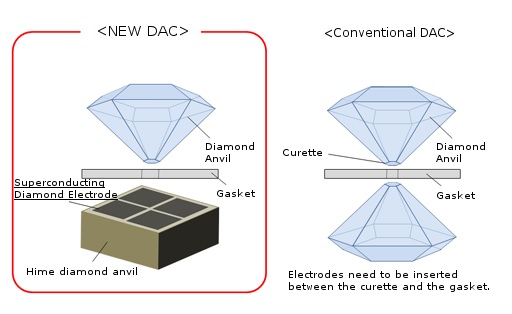High-Pressure Generator Using a Superconducting Diamond Developed

Figure: Structures of diamond anvils. In the new DAC, a Hime diamond was used as a lower anvil and a superconducting diamond, which serves as electrodes, was fabricated on top of the anvil. In the conventional DAC, pressure is generated by two pointed curettes of the lower and upper diamonds pressing on each other. In this system, electrodes need to be inserted between the curette and the gasket. Copyright : NIMS
Researchers of National Institute of Materials Science and Ehime University, Japan, developed a new diamond anvil cell by micro-fabricating a superconducting diamond, which conducts electricity like metal and serves as electrodes, on the world’s hardest and chip-proof nano-polycrystalline diamond.
A research group led by Yoshihiko Takano, a leader of the Nano Frontier Superconducting Materials Group, Environment and Energy Materials Division, NIMS, and another research group led by Tetsuo Irifune, a director of the Geodynamics Research Center (GRC), Ehime University, jointly developed a new diamond anvil cell (DAC) by micro-fabricating a superconducting diamond, which conducts electricity like metal and serves as electrodes, on the world’s hardest and chip-proof nano-polycrystalline diamond (Hime diamond). As a result, the conventional practice of skillfully attaching four electrodes to a small sample (of several dozen microns) was eliminated, and thus electrical resistance measurements under ultra-high pressure have become much easier. Furthermore, because diamond electrodes can be used repeatedly, physical property measurements have dramatically improved in terms of work and economic efficiencies.
As shown in the right diagram in Figure 1, a typical DAC is a device to generate high pressure by pressing curettes of paired diamond anvils on each other. To increase the pressure generated by the device, it is necessary to make the areas of the curettes smaller. Specifically, to generate ultra-high pressure (several hundreds of thousands of atmospheric pressure), curettes need to be about 400 microns in diameter.
Operation of such a device would be very difficult due to the requirement that the sizes of the samples to be studied need to be as small as about 100 microns. To generate a million atmospheric pressure or higher, the sizes of the samples need to be even smaller, making it extremely challenging to manually attach electrodes to the samples.
Accordingly, research group micro-fabricated superconducting diamond electrodes on the top of the anvil using the electron-beam lithography method. As it is convenient to use a plate-shaped diamond for the fabrication of electrodes using lithography, they combined a plate-shaped diamond and another diamond with a curette to form a diamond anvil cell with its shape as shown in the left diagram in Figure 1.
As a result, research group succeeded in developing a new diamond anvil cell by combining the world’s hardest diamond electrodes and the world’s hardest diamond anvil. Because advanced experimental technologies are required, materials R&D under ultra-high pressure is still largely unexplored. As such, this field has great potential to offer opportunities for exploring novel materials and superconductors with extraordinary functions. We believe that this new technology will contribute to Japan’s advancement in materials development.
A part of this research was supported by the Premier Research Institute for Ultrahigh-pressure Sciences (PRIUS), which has been recognized by the Ministry of Education, Culture, Sports, Science and Technology as a shared-use research facility.
This study was presented on February 23 at a PRIUS Symposium to be held at the Geodynamics Research Center (GRC), Ehime University.
Associated links
Media Contact
More Information:
http://www.researchsea.comAll latest news from the category: Materials Sciences
Materials management deals with the research, development, manufacturing and processing of raw and industrial materials. Key aspects here are biological and medical issues, which play an increasingly important role in this field.
innovations-report offers in-depth articles related to the development and application of materials and the structure and properties of new materials.
Newest articles

Sea slugs inspire highly stretchable biomedical sensor
USC Viterbi School of Engineering researcher Hangbo Zhao presents findings on highly stretchable and customizable microneedles for application in fields including neuroscience, tissue engineering, and wearable bioelectronics. The revolution in…

Twisting and binding matter waves with photons in a cavity
Precisely measuring the energy states of individual atoms has been a historical challenge for physicists due to atomic recoil. When an atom interacts with a photon, the atom “recoils” in…

Nanotubes, nanoparticles, and antibodies detect tiny amounts of fentanyl
New sensor is six orders of magnitude more sensitive than the next best thing. A research team at Pitt led by Alexander Star, a chemistry professor in the Kenneth P. Dietrich…





















